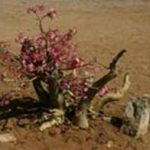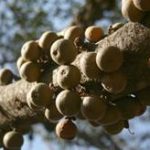TREE LIFE
November 2016
MASHONALAND CALENDAR
Saturday November 5th: Botanic Garden Walk. This will be the last walk in the Garden for this year. We might have had a little rain, but even if not, there is sure to be something exciting to identify. And a walk in the Garden is always a great pleasure.
Sunday November 20th: Imire Game Park, Hwedza. As mentioned last month, we have been invited to Imire to botanise and partake of the famous Sable Lodge picnic lunch at the dam, all for the price of $15 per head. We will be botanising along the river below the dam wall, close to the bush camp where there is some wonderful potential, especially if there has been some rain. For catering purposes please contact Mary L. by 10th November, at the latest, if you would like to join the group. We will meet at Mukuvisi Car Park at 0815 for 0830 departure. Bring chairs, hat drinks, etc.
Saturday November 26th : We return to Haka Game Park and we hope to be able to cross the vlei to the vegetation on the other side – as long as the crossing is not too wet. Meet at the gate at 1415 for 1430 hours. Bring a chair and, if you would like, a sundowner to have while watching the game on the vlei after the walk. MCL will try to negotiate a special entry price and will advise in the pre-outing notice that is sent out.
PLANTED TREES OF HARARE White Jacarandas
The last Tree Life (October 2016) contained an article on Jacaranda mimosifolia, a genus of 49 species of flowering plants in the family Bignoniaceae, which is native to tropical and subtropical regions of the Americas. Jacaranda mimosifolia or Blue Jacaranda is the species we know in Zimbabwe but I certainly don’t think it has blue flowers – purple, lilac or mauve is more like it! But, we also have a variant of Jacaranda mimosifolia or perhaps it is Jacaranda mimosifolia ‘Alba’ which has white flowers.
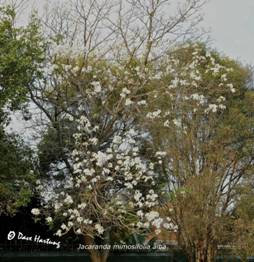
White jacaranda tree Photo by Dave Hartung
The white Jacaranda tree in all respects is exactly the same as the purple variety in terms of foliage, bark and pods. The difference, apart from the white flowers, is that it appears to be smaller than any nearby blue Jacaranda. The two photos are taken by Dave Hartung of the tree in Piers Road, opposite Bon Marche in Sam Levys Village.
I’m aware of a few other white Jacarandas in our city as listed below:
• Two street trees, with one purple tree in-between them, along Samora Machel, opposite the Tel-One College. They are in front of properties 148 & 152 Samora Machel Ave.
• One tree in 195 Enterprise Road opposite the Chisipite shopping centre.
• One street tree at 155 Baines Ave. between Sixth and Seventh Streets.
• One tree close to the road in the property of 41 Ridgeway North.
• One tree in Harare Gardens behind Livingstone House.
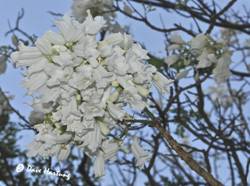
White jacaranda flowers Photo by Dave Hartung
No doubt there are many more in Harare and elsewhere. If you know the location of any which are visible from the road, apart from those listed above, I’d be interested to hear from you.
Zimbabwe has an indigenous Pink Jacaranda, Stereospermum kunthianum, which also belongs to the family Bignoniaceae. Within Zimbabwe, their natural habitat is the Zambezi Valley, extending south to Harare and surrounds. Although the shape of their flowers resembles the exotic species, their leaves, bark and pods are quite different. Exotic Jacarandas have large twice-pinnate leaves whilst the indigenous variety has medium sized once-pinnate leaves. Pink Jacarandas are becoming more popular as an ornamental garden tree and many have been planted in Harare.
– Tony Alegria
Delonix regia – Flamboyant Family: Fabaceae
November is the month when the streets of Harare turn from royal purple to regal red, as Delonix regia, with its flamboyant display of magnificent orangey-red flowers, comes into bloom. The Flamboyant, a fast-growing tree, has been planted in tropical and sub-tropical climates all over the world and because it is drought tolerant as well as adapted to a wide range of well-drained soils, from acidic to alkaline and from loamy to gravelly, it has naturalised in many parts.
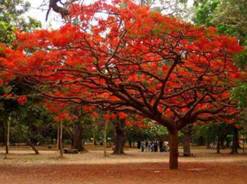
Delonix regia tree
The tree belongs, like so many of our indigenous miombo species, to the legume subfamily Caesalpinioideae. However this species is endemic to Madagascar’s dry deciduous forests. Although the common names are similar-sounding, it should not be mistaken for the Flame Tree (as in Flame Trees of Thika), which is Spathodea campanulata or the Australian (Illawarra) Flame Tree, which is Brachychiton acerifolius. Now it becomes clear why we use those long botanical names so as not to confuse species. Unlike in Zimbabwe, in some parts of the world the Flamboyant is known by its older name, the Royal Poinciana, and when I first heard this in Australia, I was convinced it was because the Australians did not know the difference between a Poinsettia and a Flamboyant!
In addition to its ornamental value, because it usually grows to about 5m (max. 12m) and spreads widely, it is also a useful shade tree, its dense foliage providing full shade. In areas with a marked dry season, it sheds its leaves during the dry period, but in wetter areas it is virtually evergreen.
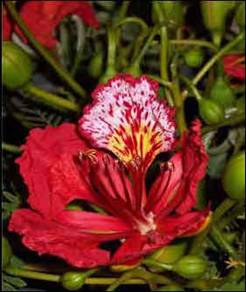
Delonix regia flower
The flowers of Delonix regia in Zimbabwe appear in late October to December. They grow in corymbs along and at the ends of branches. They are large, with four spreading scarlet or orange-red petals up to 8 cm long and a fifth upright slightly larger standard petal that is spotted with yellow and white. There are also naturally occurring yellow varieties, one that I know of grows in the grounds of Parirenyatwa hospital in Harare and another in Mutare.
The bipinnate compound leaves have a feathery appearance and are a characteristic light, bright green. Each leaf is 30–50 cm long with 20 to 40 pairs of pinnae, each divided into 10–20 pairs of pinnules.
The pods are green and flaccid when young and turn dark-brown and woody. They can be up to 60 cm long and 5 cm wide. The seeds are small.
Uses: The species has an impressive list of medicinal uses. The flowers, the leaves, the stem and the bark are all used medicinally because of their antimicrobial, antioxidant, anti-inflammatory, anti-diabetic, wound healing, diuretic, antidiarrheal, cytotoxic, anti-ulcer, anthelmintic and photo-remediative properties. The species is also valued for religious reasons in some countries.
Sources :
Wikipedia: Delonix regia.
https://en.wikipedia.org/wiki/Delonix_regia
– Isla Grundy
OUTING TO HUMANI RANCH, SAVE CONSERVANCY
DAY THREE- Sunday 18 September
This morning a cold front arrived, very welcome after a stifling hot Saturday. Our aim for the morning was a botanising drive to the big Baobab tree.
After breakfast we all climbed into three vehicles, the big open Humani landcruiser and two of our own vehicles. Our first stop was just on the other side of the Turgwe River from our camp. Our guide and driver, Lymon, stopped to look at black rhino tracks and he took the trouble to point out to us that you can identify a rhino’s dropping by the chopped up grass stalks in it, otherwise it could be confused with elephant droppings. In this lovely riverine forest the botanists identified Capparis sepiaria (Hedge Caper Bush); Maerua parvifolia (Dwarf Bush Cherry); Senegalia (Acacia) schweinfurthii, River Climbing Acacia; Philenoptera (ex Lonchocarpus) bussei; the spiny scrambling shrub Azima tetracantha (Needle Bush), Croton megalobotrys (Feverberry) and Xanthocercis zambesiaca (Nyala Berry).
We continued our drive through beautiful forest, with Natal Mahogany (Trichelia emetica) and Faidherbia albidas, Sausage Trees (Kigelia africana), Ilala palms (Hyphaene petersiana) and Albizias with lovely red pods,(Albizia versicolor) and Rain Trees (Philenoptera violacea). We stopped when we saw a herd of female elephants with calves ahead of us. After a long wait, they had not moved so Lymon asked the guys behind us to turn their vehicles and we went on to try to move them, I think. Well, they were having none of it. They joined ranks and flapped their ears, trumpeted, kicked the soil and threatened to charge us. Lymon grabbed his gun and fired over their heads but they barely reacted, just joined ranks. They gave us a few more warnings, Lymon shouted some warnings back at them and revved the engine, so they backed down but still didn’t make way for the vehicle.
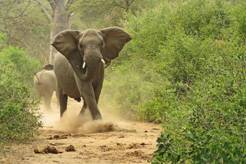
Elephants at Humani Photo: Meg Coates Palgrave
So we gave up, turned our vehicle and headed back the way we had come to find another route. We all had a good shot of adrenaline and poor Meg, sitting behind the driver when he fired, had a very deaf ear.
As we drove on we enjoyed seeing warthogs, nyala, kudu and lots of magnificent giraffe and a few zebra. We left the riverine forest and our next stop was next to a rocky outcrop. Here we identified Gardenia resiniflua (I think) and a Pod Mahogany (Afzelia quanzensis) with no leaves but the few remaining pods gave it away, and likewise the little wooden bananas gave away the silvery Entandrophragma caudatum. We also identified Sterculia rogersii (Small-leaved Star Chestnut), Ipomoea sp., Salvadora persica (Mustard-tree), Euphorbia (was it cooperi?) and lots of Diospyros quiloensis (Crocodile Bark) and Commiphora glandulosa (Tall Firethorn Corkwood).
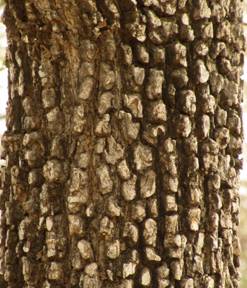
Diospyros quiloensis (Crocodile Bark) Photo: Isla Grundy
A bit further on Mark stopped Lymon to look at a beautiful tree completely covered in white fluffy flowers. It was a Large-flowered Spike Thorn which has the charming Latin name of Gymnosporia putterlickioides! The botanists were most excited about this. I think we also saw another African Osage-orange (Maclura africana).
Finally we got to our destination for the morning – well, not the big Baobab as originally planned but, for me, even better. We stopped at an absolutely enormous fig tree. It looked like a strangling fig – masses of twisting roots covering the entire trunk and growing down from many of the branches. We could not see any host tree. There were strange new trunks growing down from some of the big branches – some distance from the main trunk, I think five in all. I just loved the deep layer of leaves lying all around under the tree, soft to walk on. There was some debate as to which fig it was – the fruit were small, on small branches – we saw some lying on the ground. Perhaps it was Ficus ingens?
We were happily posing for team photos when I suddenly noticed poor Mary shaking like a leaf next to me. She was freezing cold. Luckily Mary’s daughter was with us and as she is a doctor, she took control. But suddenly we were no longer interested in botanising, we were all only anxious to get Mary home and warmed up and treated. It had been a cold day and she had been sitting in the front of the vehicle when the elephants had frightened us, as well as overdoing it organising such a fantastic weekend for us all. We were all upset to see her in shock. She recovered a little on the way home but, in spite of antibiotics, the fever was to plague her for the rest of the weekend.

Gardenia volkensii. Photo Bart Wursten Flora of Zimbabwe
Somewhere along the way I know we saw two varieties of Gardenia, one white (Gardenia resiniflua) and one yellow (Gardenia volkensii).
In the afternoon we went out at four so that those who missed the big Baobab in the morning could see it after all. By now we were a bit cold and tired to take in much, but Lymon told us a great tale about how a poacher had been stealing salt from Humani’s Bedford camp and, at the centre of the huge Baobab, had been using it to cure impala he had poached. When the salt was missed, the staff finally realised that there was poacher nearby and he was caught red handed.
We got home in the dark, ready for another Humani feast.
-Tempe van der Ruit
OUTING TO CHIVERO ORNITHOLOGICAL RESERVE SUNDAY 16TH OCTOBER 2016
Only Mad Dogs and Englishmen go out on a Tree Society botanising walk in a leafless woodland at Chivero Ornithological Reserve on a VERY HOT October day. It was confirmed that there are only 7 members of our Society who fall into this category! We went, we saw, we sweated, but it was generally agreed that it was a good day, and a good time was had by all seven of us, that is Tony, Dave, Graham, Bilal, Jan, Vera Neill and myself. So good to see you again Vera, and thank you for braving the heat to join us.
The Urban Sprawl of “wall to wall” housing, informal trading – be it chickens, goats, old tyres, tomatoes, rape or chibuku or road side gatherings – together with crater sized potholes and inebriated cyclists made the drive more than a little challenging!
Apart from the beautiful new, now green foliage of the Brachystegia spiciformis, we were hard pushed to find leaves. First to get our attention was Pavetta gardeniifolia, Stink-leaf Brides Bush or Common Bride’s Bush, with its few obovate leaves clustered on reduced lateral branchlets, and just coming into bud. Then Pterocarpus angolensis, Mukwa or Bloodwood with its rough and longitudinally fissured bark. A small scratch on the bark and we were able to observe the blood-red sticky sap oozing out – hence Bloodwood. Another specimen of P. angolensis was in flower, large panicles of orange-yellow attractive flowers but a bit too high up to examine properly. We then saw Pterocarpus rotundifolius with its pairs of opposite to sub-opposite leaflets, plus the rounded terminal leaflet the apex of which is rounded and notched and very velvety. This too, was coming into bud. Dichrostachys cinerea, Sickle-bush or Chinese Lantern, got a lively discussion going on thorns/ spines/ spikes or prickles.
Next was Steganotaenia araliacea, the Carrot Tree, with its now dry foliage, still smelling of carrots when crushed, and its pale green bark peeling in small papery flakes – we saw a few of them. Nearby was a Gymnosporia senegalensis, the Red Spike-thorn or Confetti-tree (with no confetti), and Ochna pulchra, the Peeling-bark Ochna. Bobgunnia (ex Swartzia) madagascariensis, the Snake-bean was coming into flower, but identified mainly by its dark brown, slender sausage-shaped pod. And close by, the highlight of my day, Securidaca longepedunculata, the Violet Tree, just coming into flower and oh so very lovely. Nearby was a carpet of what Dave called “ivory carpet” – a suffrutex producing wonderful Gardenia-scented flowers in the spring – Leptactina benguelensis. Its fruit are like miniature rugger-balls with persistent calyces like Gardenia.
We saw Parinari curatellifolia, Mobola Plum; Peltophorum africanum, the African Wattle; Indigofera rhynchocarpa (Hockey Sticks), Senna singueana, Winter Senna; Strychnos cocculoides, Corky-bark Monkey Orange; Strychnos potatorum, Grape Bitterberry; Terminalia sericea, Silver Cluster Leaf; Vitex payos, Chocolate Berry; Acacia sieberiana, Paperbark Thorn; Albizia amara, Bitter Falsethorn; Azanza garckeana, Snot Apple; Burkea africana, Wild Syringa; Capparis tomentosa, Woolly Caper Bush, Clerodendrum eriophyllum, Hairy Tinderwood; Combretum molle, Velvet Bushwillow (Meg’s ‘Wish Tree”), Combretum collinum, Variable Bushwillow; Diospyros lycioides, Red Star Apple; Euclea crispa, Blue-leaved Euclea; Faurea saligna, Willow Beechwood, Ficus burkei, Common Wild Fig; and many beautifully shaped Gardenia volkensii, the Woodland Gardenia. On the anthill where we were picnicking was a very fine specimen of Schotia brachypetala (Weeping Boer Bean), flowering in all its glory.

Securidaca longepedunculata. Photo: Bart Wursten, Flora of Zimbabwe.
We were glad to get back to the “sort of” shade of our vehicles and to cold drinks, chairs, and relaxing while we cooled off and ate our lunch. We were somewhat surprised to find it was only just after noon when we had finished our lunch. Then came the real “Mad Dog” bit when we set off across the burnt reeds to the lake shore to see what we could see there in the way of bird life. Pied Avocet, Red-billed Teal, Black-winged Stilt, Red-winged Pratincole, Ringed Plover, White-breasted Cormorant, Sandpiper, and Fish Eagle, according to Dave Hartung. Again, we were very pleased to get back to the cars, to cool off again and set off for home by 1400. I think, considering the weather, it was an excellent outing with good company.
To cap the day, on the way home we passed a very beautiful Securidaca longepedunculata, in full flower. It was up against a fence where there was a lively beer drink going on. Bilal braved the short walk through thick bush and the threat of being caught stealing, and picked me a wonderful stem of flowers which today, Tuesday, still graces my lounge. This was definitely the crowning glory of the day. Thank you Bilal.
– Mary lovemore
TONY ALEGRIA CHAIRMAN


